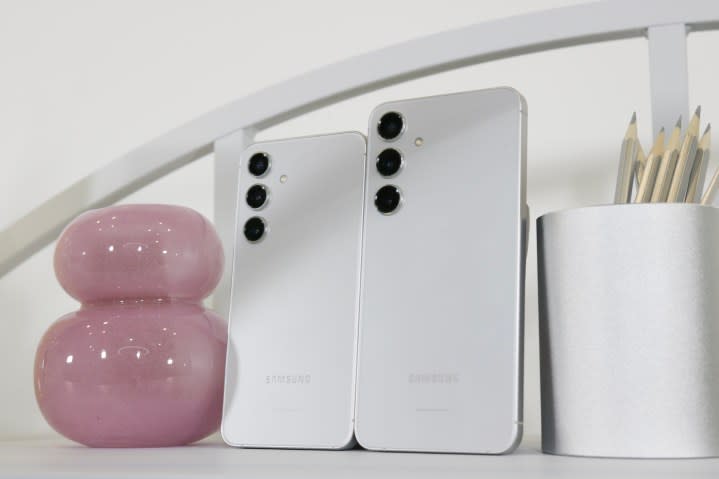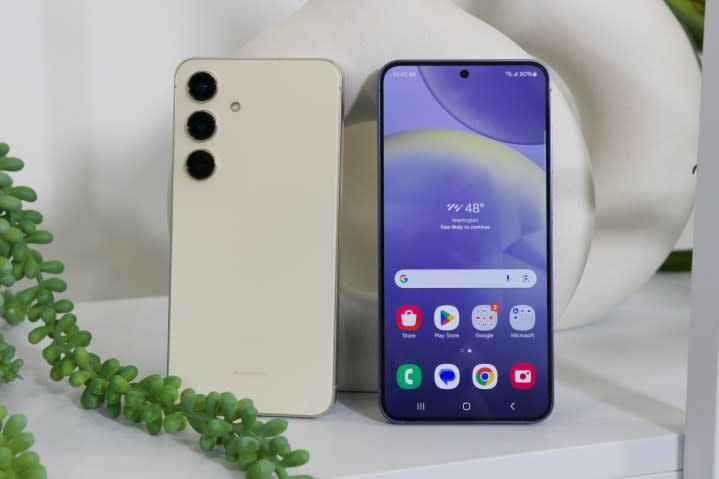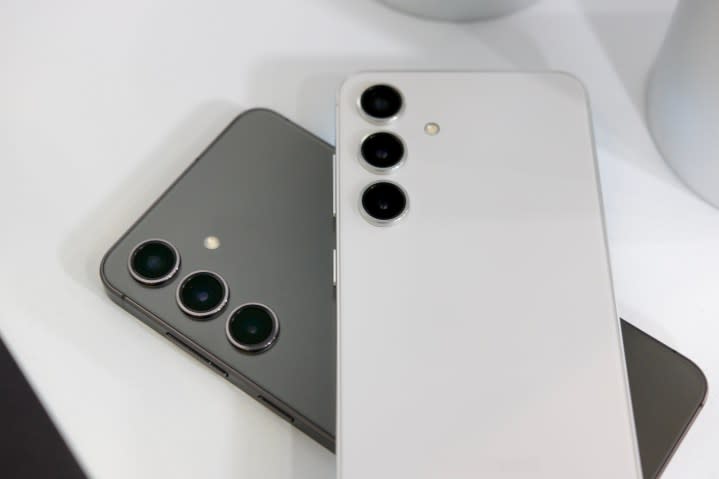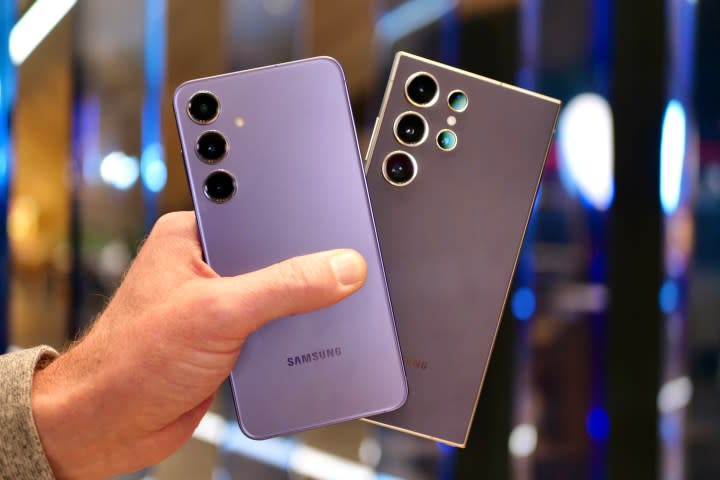Samsung may have made a horrible decision with the Galaxy S24
This article contains affiliate links; if you click such a link and make a purchase, Digital Trends and Yahoo Inc. may earn a commission.

The big Android dogs from Samsung —the Galaxy S24 series — are out to challenge the smartphone supremacy crown in 2024. There are minor design improvements, a faster chip, a slightly tweaked camera, a big jump in thermal management capacity, and loads of AI hype around them.
Some of those AI features come courtesy of Qualcomm’s Snapdragon 8 Gen 3 for Galaxy silicon, while others are built in-house or with some help from Google. But behind the scenes, Samsung has again employed a controversial two-chip sales formula.
In the U.S., all three Galaxy S24 models will draw power from Qualcomm’s flagship chip. In other markets, Samsung will only arm the Galaxy S24 Ultra with Qualcomm’s Snapdragon 8 Gen 3 chip, while the more affordable Galaxy S24 and Galaxy S24 Plus trims will get the in-house Exynos 2400 processor.
A shameful lack of faith

Affordable is a relative term here. The Galaxy S24 Plus starts at $1,000 in the U.S., while the entry-point version will have you spending at least $800. The Galaxy S24 Ultra has been spared the Exynos treatment, apparently because it’s even more expensive this year at $1,300.
That’s a $100 premium over the iPhone 15 Pro Max, making it the most expensive non-foldable phone out there. Or, as some Wall Street analysts would say, innovation comes at a cost. But that’s not the worst part. Apparently, Samsung itself seems to have little faith in its own Exynos silicon.
Nowhere in the official press material does Samsung advertise the virtues of its Exynos 2400 as much as Qualcomm’s silicon. The embargoed information sent to the U.S. media doesn’t mention Exynos at all. Who is Samsung trying to hide the Exynos from? The media, or the buyers who don’t get to see an Exynos processor marketed feverishly for a thousand-dollar phone?
Now, the Exynos fiasco is not exactly a secret. I’ve been following the poor trajectory of Samsung’s mobile processors since the Exynos 990 (inside the Galaxy S20 series), which was thoroughly trounced by the Snapdragon 865 back then. A year later, the Snapdragon 888 proved Samsung’s Exynos 2100 needed to cover a lot of ground, especially in the graphics department.

In 2022, the Snapdragon 8 Gen 1 once again raced ahead of the Exynos 2200 by a healthy margin. But a phone is not merely how fast its processor can go. It’s a sum of many parts. Alas, the Exynos shortcomings spilled over into many other departments, as well.
The experts at DxOMark and independent testing have also highlighted that Qualcomm-powered Galaxy flagships offer a better camera experience than those with an Exynos chip inside. That’s quite ironic, given the fact that Samsung takes a lot of pride in the camera chops of its Galaxy S portfolio.
Side-by-side comparisons have also laid bare the facts that Galaxy flagships with a Qualcomm processor inside can manage sustained peak performance for a longer duration, consume less power under load, and fare better at idle power consumption. App launch speed tests also show that the Qualcomm-powered variants are snappier. XDA product forums, Reddit, X, and Samsung’s own Community chats are littered with Exynos-Galaxy complaints.
At this juncture, we don’t know if the Exynos 2400 will reverse the fortunes, but for the kind of money Samsung is asking for even the cheapest Galaxy S24 variant, I would much rather invest in Qualcomm-backed Android flagships such as the upcoming OnePlus 12. And not solely for the added dash of firepower. The reason is AI, and it extends well into the future of the entire smartphone industry.
2024 is a different ballgame

Google’s Pixel 8 Pro has made it abundantly clear that AI is not the same kind of vaporware as NFTs, crypto, and Web3. Generative AI tricks based on large language models are here to stay and change phones in a meaningful way. Qualcomm and MediaTek are doing their best to cram generative AI smarts inside phones across premium and midrange segments.
Even Samsung went all-in with the Galaxy AI theme for its latest phones. Nothing has come out of their flashy demos and bold promises so far. Samsung can change that. The Galaxy S24 promises neat tricks like real-time voice and text translations for voice calls, an offline language interpreter, and a chat assist that refines your messages (akin to tools like the Paragraph AI keyboard).
A message summarization system for Android Auto à la, the excellent Shortwave email app, and some ChatGPT-esque summarization features for note-taking and audio recording.
But then, the real “wow” class of generative AI tricks are tied to Qualcomm’s Snapdragon 8 Gen 3, and so far, we don’t know if the Exynos 2400 will pull them off as well. Among them is Generative Edit, which lets you move around subjects in a picture and adjust the canvas size by adding more elements to it using generative AI.
Adobe Photoshop (beta) x Adobe Firefly: Announcing Generative Fill
Call it pixel-level smart auto-fill, if you will. It almost works like magic, as seen in the Adobe video above. It won’t be as impressive on smartphones, but the vision could be a precursor of great things to come. Qualcomm says the Snapdragon 8 Gen 3 enables text-to-image generation using Stable Diffusion in less than a second.
The chip also opens the doors for voice-enabled photo and video editing. There’s even a system to remove objects in photos, just like Google’s Magic Eraser feature for Pixel phones.
Samsung’s double whammy

These features might sound gimmicky to some, but there’s a lot more to on-device generative AI than just adding some snazzy effect to photos. It is going to decouple a lot of processes from the cloud, making tasks a lot faster as well as safer. The Gemini Nano model doing its job on the Pixel 8 Pro is just one example, with the Galaxy S24 powered by Snapdragon 8 Gen 3 following in those footsteps.
In this case, Qualcomm took it upon itself to bake those AI features on its silicon. Unfortunately, we don’t know if Samsung went the extra mile with these on-device generative AI capabilities for the Exynos 2400, while also narrowing the performance and experience gulf with Qualcomm-driven flagships.
We have reached out to Samsung for clarity on the situation, but so far, it seems hundreds and thousands of Galaxy S24 shoppers are in for a worse Exynos surprise this year than they were in 2022 or the years prior.
It’s just ironic that Samsung’s bet on AI is what’s going to bite the fans. Mind you, these are fans who pay a lot more for a Samsung flagship in their home market than what an average U.S.-based buyer has to part ways with, so there’s that stinging reality, too.

